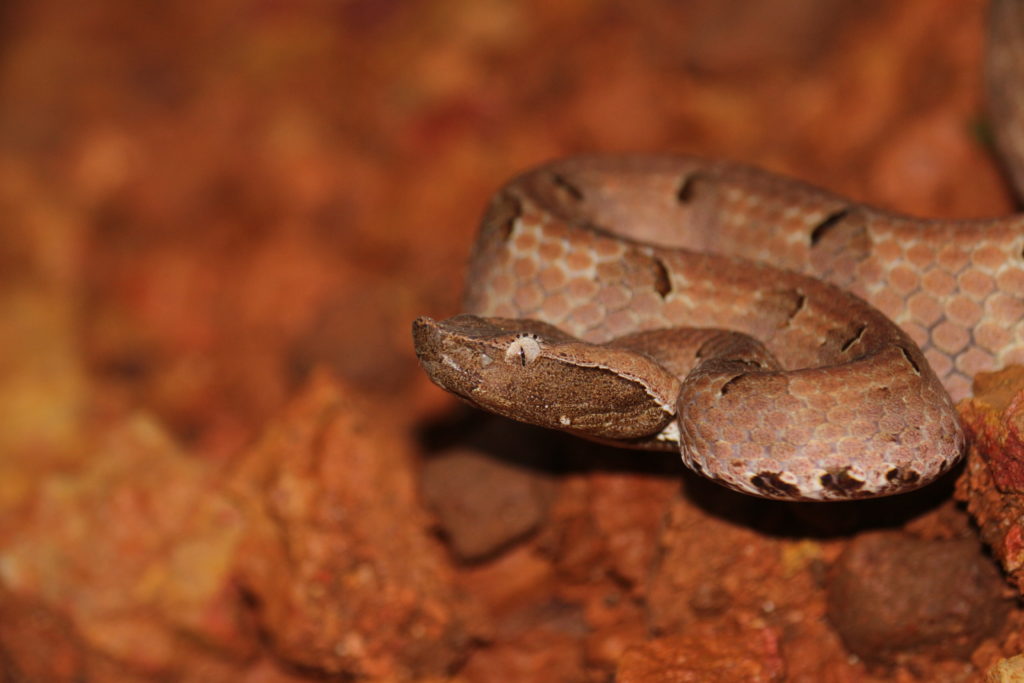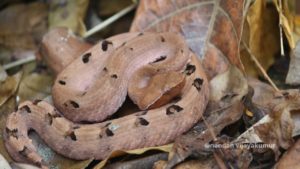Pit Viper
Hump Nose Pit Viper
(Crotalinae)

Pit vipers (Crotalinae) are the sub-family of vipers (Viperidae). What makes this snake unique is that they have a common characteristic: a deep pit, or fossa, in the loreal area between the eye and the nostril on either side of the head. These loreal pits are the external openings to a pair of extremely sensitive infrared detecting organs, which in effect give the snakes a sixth sense that helps them to find and perhaps even judge the size of the small warm–blooded prey on which they feed.
The pit organ is complex in structure and is similar to the Thermo receptive labial pits found in boas and pythons. It is deep and located in a maxillary cavity. The membrane is like an eardrum that divides the pit into two sections of unequal size, with the larger of the two facing forwards and exposed to the environment. The two sections are connected via s narrow tube, or duct, that can be opened or closed by a group of surrounding muscles. By controlling this tube the snake can balance the air pressure on either side of the membrane.
The membrane has many nerve endings packed with mitochondria. Succinic dehydrogenase, lactic dehydrogenase, adenosine triphosphate, momoamine oxidase, generalized esterase and acetylcholine esterase have also been found in it. When prey comes into range, infrared radiation falling onto the membrane allows the snake to determine its direction. Having one of these organs on either side of the head produces a stereo effect that indicates distance as well as direction. They are nocturnal, venomous snakes with large hypodermic needle like fangs. They are nocturnal, venomous snakes with large hypodermic needle like fangs. They are thick stout snakes with triangular-shaped head and eyes that contain vertical pupils providing clear sharp vision. It grows to an average of 30-45 cm in length. Depending on the habitat in which they are found, pit vipers can vary in colors .The color pattern is grayish with a heavy brown mottling, overlaid with a double row of large dark spots.
IMPORTANCE OF THE PIT
They can be distinguished from other vipers by the presence of hear sensing pit like organ located between eye and nostril. This organ can sense infrared heat and has proven to be physiologically beneficial to Pit viper. They help in prey acquisition, predator defense, and thermoregulation .The pit senses body heat from animals and gives the snake a picture of that animal.
MORPHOLOGY OF PIT
The pit organs of pit vipers are located in between the eye and the nostril on each side of the head. The pit organ in pit vipers consists of several main parts; the outer chamber, the inner chamber, a thin membrane that separates the two, and a pore. Contained within the thin membrane separating the chambers are the actual infrared receptor terminal nerve masses. The pore serves as an equalizer of atmospheric pressure similar to the Eutachian tube in mammals. The pit organ in pit vipers is located away from the body giving it a greater sensitivity to infrared radiation while avoiding heat given off the body that may distort the stimuli aimed at the infrared receptors. Along the outer and inner chambers are oberhauchten cells covered in tiny pores. The inner chamber also contains domed structures covered in these pores. These pores serve to reflect wavelengths in the visual spectrum that may inadvertently increase the temperature of the receptors and blur the infrared image.
NERVE INNERVATION
The thin membrane of the pit organ is innervated by the ophthalmic ganglion and maxillary ganglion of the trigeminal nerve, which is also connected to the medulla oblongata. Along with these nerve fibers, the thin membrane is also innervated by pain sensors and autonomic nerve fibers that control the blood flow to the thin membrane .The thin membrane is also filled with mitochondria and oxidative enzymes. The mitochondria and oxidative enzymes .The mitochondria and oxidative enzymes, such as adenosine triphosphatase and lactic acid, serve to produce the energy needed to generate a potential as a result of infrared stimulation.
Habitat

They are found in dense jungles having dry /cool climate and heap of dry leaves, bamboo patches, cashew plantations etc.
Behavior
They are found active during early morning and night .Spends the day time in leaf litter and thick bushes .Although it is a slow mover, is capable of last strikes .When disturbed it will become aggressive.
Predation
Pit vipers are ambush predators. This type of hunting is beneficial in that it requires little energy. As an ambush predator.pit vipers generally hunt at night. Using their tongue (chemosensory organ), pit vipers can locate an area with a high concentration of preferred prey. Then they settle into the surrounding area and hide. Using both normal and infrared vision, the pit viper waits for its prey to cross its path at which time it strikes.
Food- Mice, rodents, lizards etc
Reproduction-Ovoviviparous
Peculiarity of venom
Bites from this species ,although previously thought to be onnocuous,are now known to cause serious complications such as coagulopathy and acute renal failure (ARF).If not treated within a few hours ,bites can potentially be fatal for human beings. In the vipers, which have the most highly developed venom delivery apparatus, the venom gland is very large and is surrounded by the masseter or temporal muscle, which consists of two bands, the superior arising from behind the eye, the inferior extending from the gland to the mandible. A duct carries venom from the gland to the fang. By means of the movable maxillary bone hinged to the prefrontal bone and connected with the transverse bone which is pushed forward by muscles set in action by the opening of the mouth, the fang is erected and the venom discharged through the distal orifice. When the snake bites, the jaws close and the muscles surrounding the gland contract, causing venom to be ejected via the fangs.
Snake venom is highly modified saliva .Venom is produced and stored in paired glands below the eye. It is discharged from hollow gangs located in the upper jaw. Fangs can grow to 20mm in large rattlesnakes. Venom dosage per bite depends on the elapsed time since the last bite, the degree of threat perceived by the snake, and size of the prey. Nostril pits respond to the heat emission of the prey, which may enable the snake to vary the amount of venom delivered. Venom is mostly water. Enzymatic proteins in venom impart its destructive properties .Proteases, collagenase, and arginine ester hydrolase have been identified in pit viper venom.
Venom acts more on the vascular system and they are haemotoxic in nature. Since the venom toxicity of pit viper is less than that of other species in viperidae family it doesn’t brings about much complication to vascular system .According to geographical distribution there will be difference in the severity of venom .The variety of pit viper seen in Kerala is less venomous than those seen outside. The severity of any pit viper bite is related to the volume and toxicity of the venom injected as well as the location of the bite, which may influence the rate of venom uptake .Venom severity of Russell and saw scaled viper is more than that of pit viper, so the bite by such snakes will show defect in clotting haematuria, increased swelling etc, on the other hand such symptoms are absent in pit viper bite.


